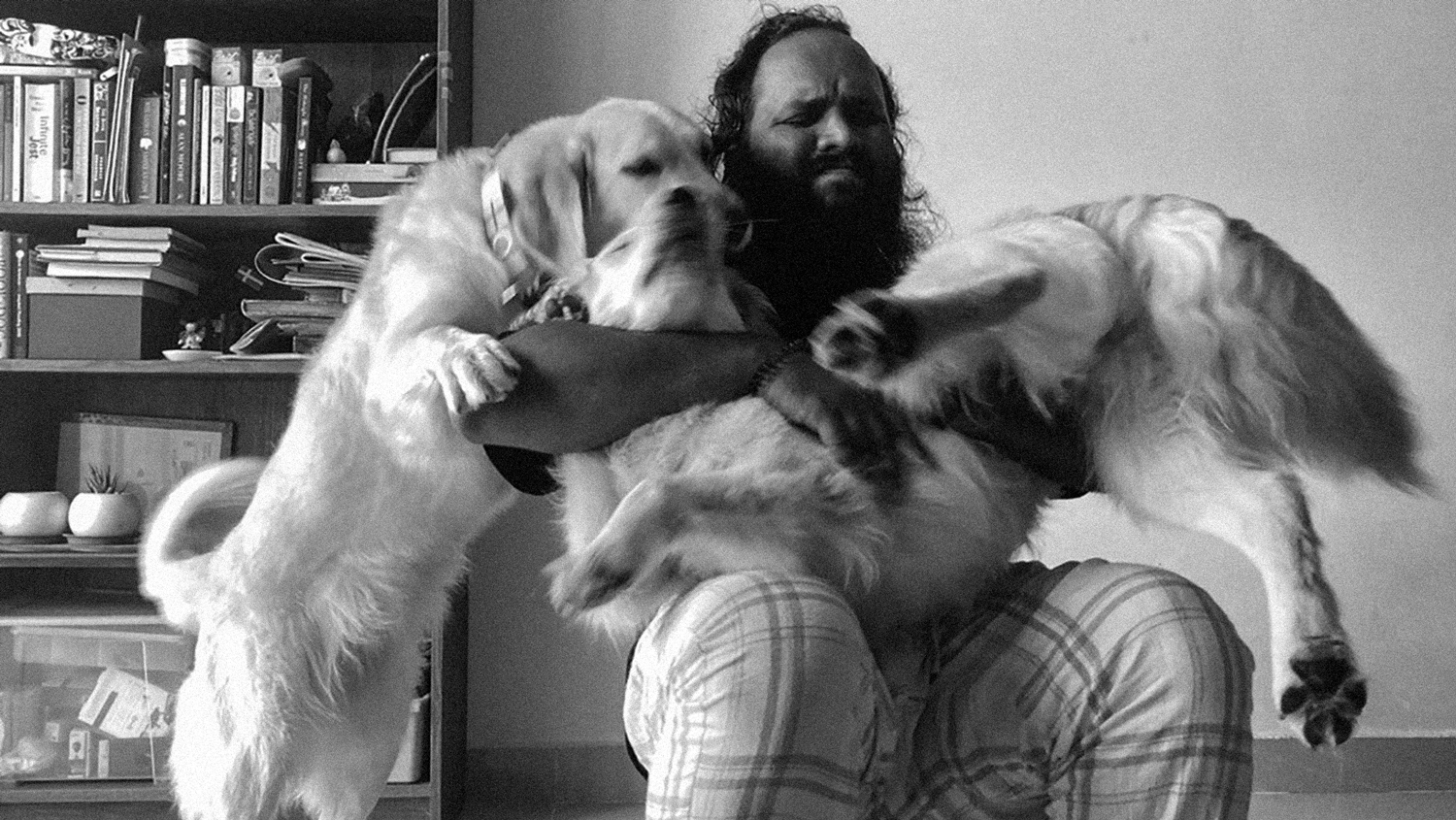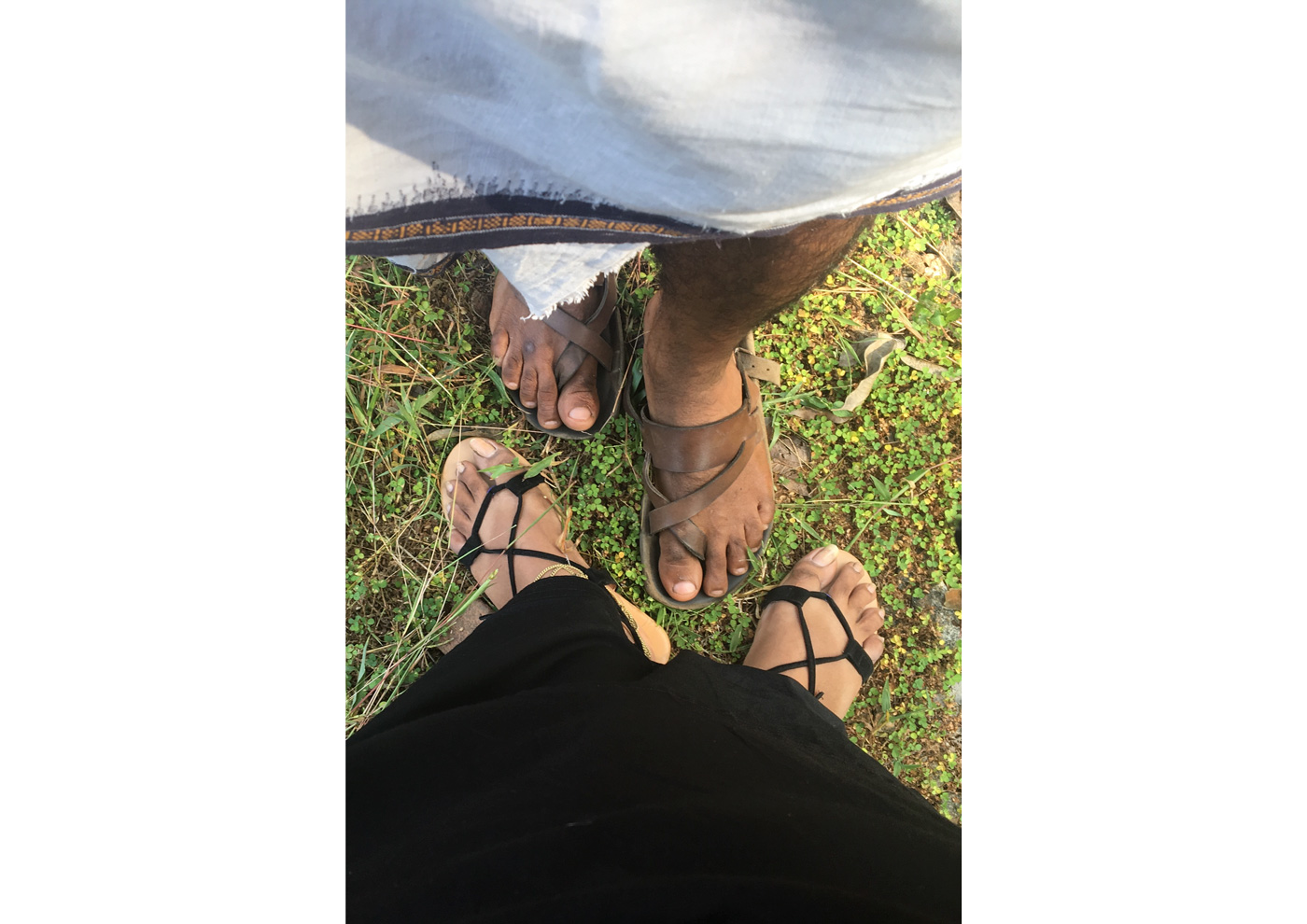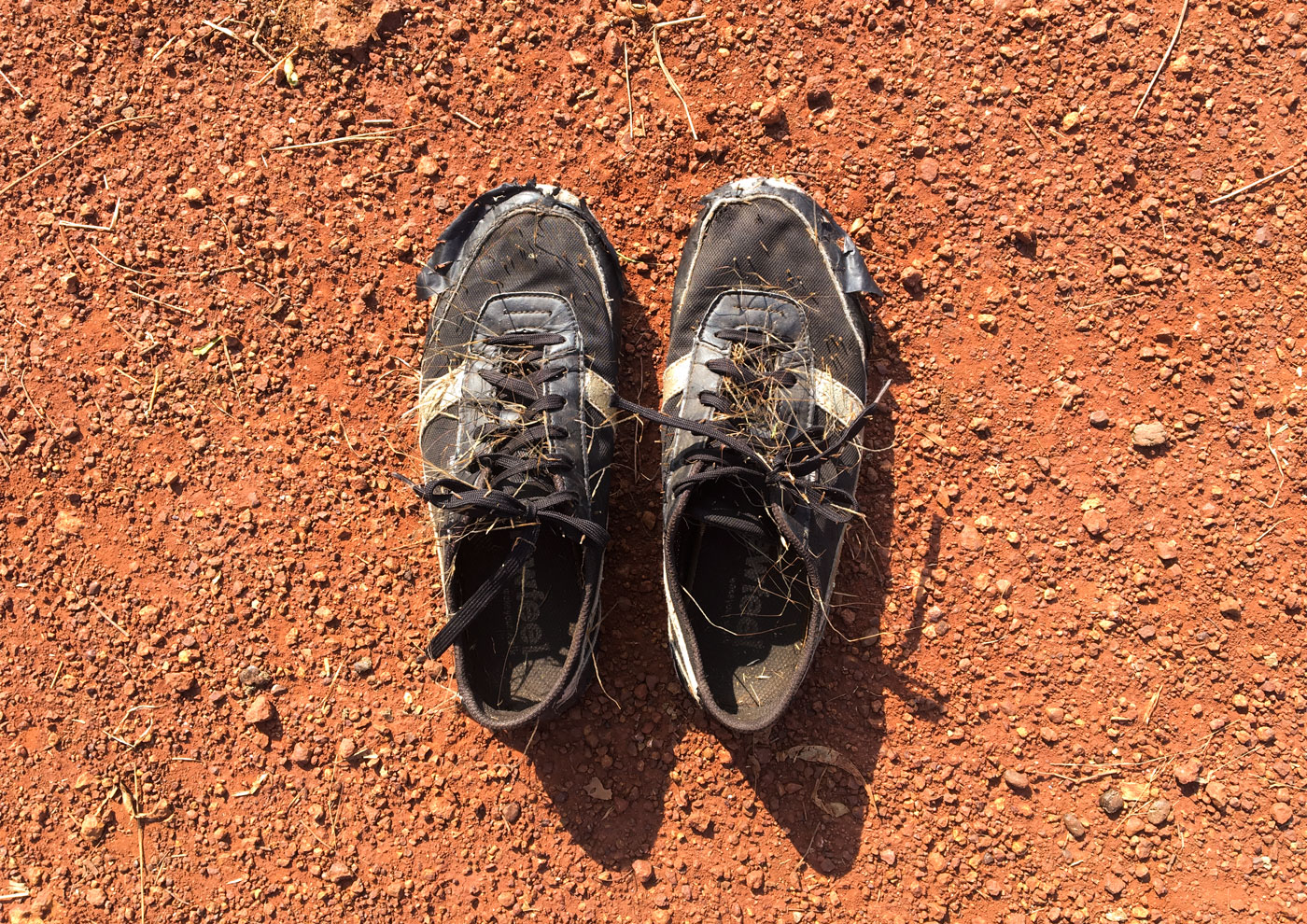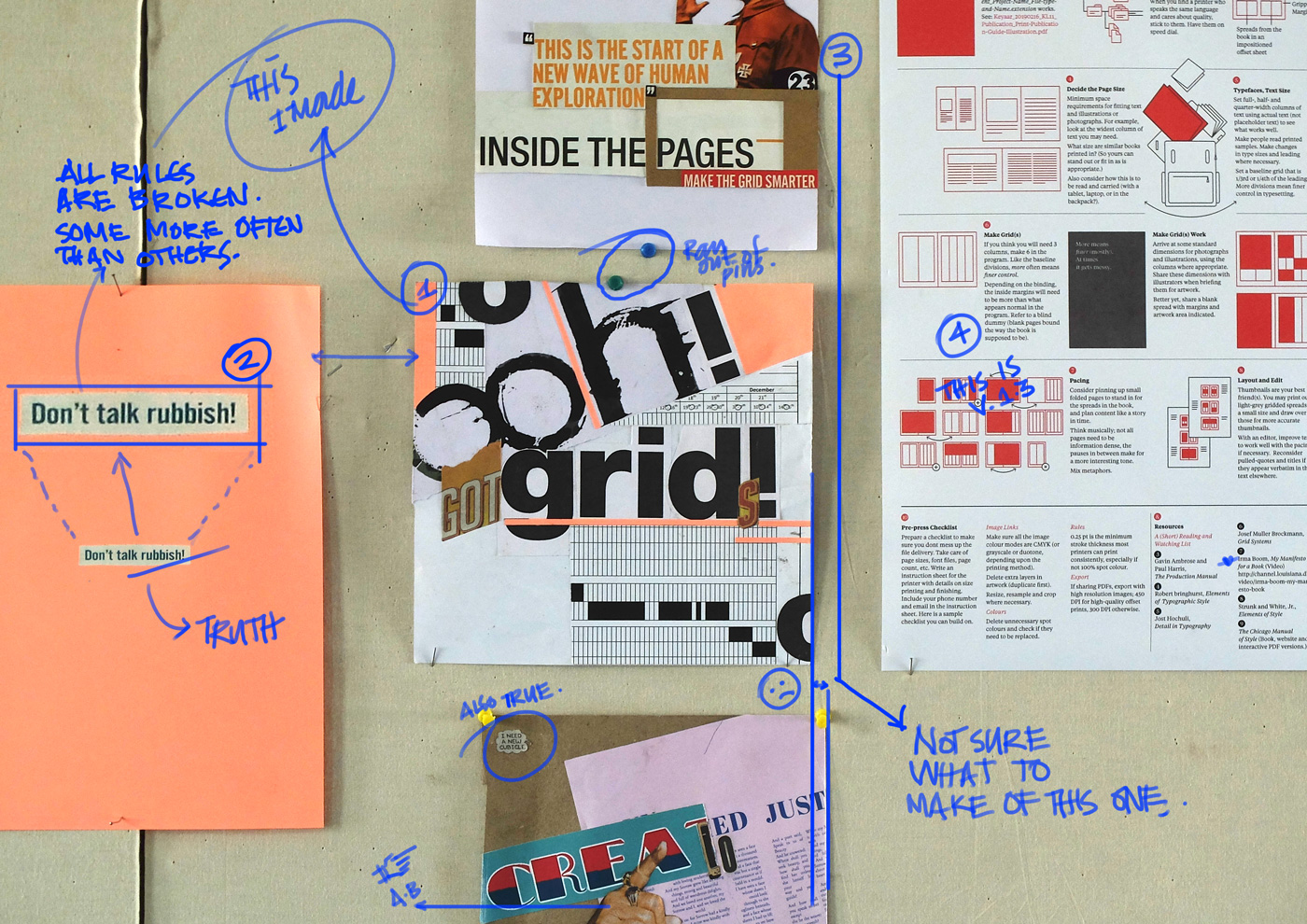The TiffinBox in Rearview
→
February 5, 2025 |
Reading time: 7 minutes | Permalink
2024 was a good-ish year. Can’t complain.
In December (right before Christmas) we brought Poppy (on the name, footnote) home from a shelter near Bannerghatta. She started at a ’year old’ and now we know—from teeth-based evidence—is a malnourished one and a half year old. She was perpetually hungry and it broke our hearts to see that. She’s up for food anytime even now, but knows there will be enough and on time and is calmer in general around things we eat. At night the bed isn’t enough anymore and on winter nights we don’t complain.
Now there is just enough floor between all the fur to build a third puppy or evenly distribute over everything in the wardrobe. We prefer the first but settle for the wardrobe thing.

The one in the air in a blur is Poppy. She’s lighter and easier to lift but goes bonkers after exactly three seconds in the air. Chellam with her Bauhaussey collar isn’t as amused by the whole setup as I am.
We (KL11 and recently R) had a fulfilling year at work. We made a ‘corporate’ book about people at River. Will post some pictures later. R took soul-filling photos of people working at the factory. (Everybody smiled.) I went to some ‘events’ and was miserable after. I went to some other ‘events’ and wanted to go to more, after.
I’ve realised work isn’t the focus this year. Not the kind that brings in money, anyway. I’ve decided to work from home more often.
The year was an absolute disaster for reading. I started more books and finished few. Much fewer than usual. It isn’t that I’m older and okay-er with not finishing books; just that I was too distracted to see things through. I’ll replace the void left by two underwhelming Kindles with a Kobo, once I get through the five books on the proverbial nightstand. (Suggestions welcome on which one to spring for. I’m more interested in the more pocketable/pocket-friendly Clara.) There is a thread on Threads from Kobo’s CEO that sold me on the company and a bunch of podcasts later, the feelings hold true-r. (There are a new set of podcasts I’m listening to, mostly while cleaning the house and its utensils, and sometimes when waiting for snoring to set in. Will share a list too.)
R is home alone with the kids most days and that is not okay. So I’m testing alternate WFH days and fifty-fifty days till we find a solution.
I am cycling more. (Or at all, finally.) Driving to work always reminded me of that tiffin-box frame from Sarnath Banerjee’s Harappa Tales (there is a single-person sitting in a disproportionately huge SUV with a single tiffin box in the rearview mirror) and it is getting increasingly difficult to find parking spots for Podimol at the HQ anyway. The other day, I’d diagonally parked outside, between the drain, an excuse for a garden, and a silver-grey KIA. The misalignment drove me angry till other unimportant store-construction measurement fiascos took over that duty for the day. I’ve got some band-less toe-cages and UV-shielded sleeves off Decathlon and have upgraded to the ultimate cycle-riding fashion statement with Sandals+Socks per Rivendell. And there is now a long overdue bar-bag on the handlebar that has fundamentally changed the way I worry about losing phones/earphones from pant-pockets, forever. I think I waited too long trying to justify another Ortleib only to fail and wisen up. The ride is a fifteen minutes thing (sometimes less, sometimes more, depending on how well the little traffic near Nallurhalli Metro behaves). It is pleasant-adjacent especially this time of the year, and I hope more riding will make it more pleasant in the summery months. In the interest of worklifebalance, I’m trying to ride as light as possible, but packing light isn’t always feeling right.
Last year I wasted a whole bunch of time doomscrolling OTT platforms. This year I’ve added TV+ to the list in hopes of getting rid of everything else. I know; logic, etcetera.
There are new input devices on the way. I threw some money at a GAS67 barebones and a Kensington Orbit WL. Can’t wait to build the keyboard and see how a static mouse feels. Then I’ll write a series of posts on all the slightly weird input devices I love. (Input tools [including the ink and paper variety] decide and often define how unique one’s work is and I want to experiment and not feel old.)
Speaking of age. I also want to cook (and eat) better. Numbers from a recent blood-test was a great reality-check and one of the ways to deal with those numbers seem to be eating well. We got an Instant AirFryer and instant air fry a whole bunch of things now. The coconut oil can is sleeping in a corner. Like all great cooks, R doesn’t like me in the kitchen when she’s in the zone. I believe I also want to feel what that feels like (being in the zone, not the being out of the zone) and be more present like her.
This was the year I invited more people home than ever. (I don’t say ‘we’ because R has always had great friends.) And I see why that is a good thing. More this year.
Moonrise in Kuppady
→
January 1, 2023 |
Reading time: ~1 minute | Permalink
The year was a mixed bag. Of many happinesses: Chellam and Podimol coming into our lives and bringing along joy and responsibilities in equal measures; moving into this lovely old house in the Nilgiris; R exhibiting work at the India Art Fair; KL11 being able to mentor students for the first time; many long trips for work and otherwise; good food; family gatherings. Of many things that humbled and saddened in excess: Kalyani’s many old-age-driven health problems; P and family’s sudden passing in a road accident; R’s papa leaving us after a week-long ICU-stay; associated complications and stresses; being with the many old people (‘bystanders’) lost in the corridors of TVM Medical College.
The courses this year were all excellent—the students did more and better work in the weeks we were together than I had any realistic right to expect. The colleges often felt less like going home—thanks to the bureaucracy and general slowness in moving things. KL11 has had a wonderful and exciting—if a bit too full of meetings—year.
But it has mostly been about loved ones leaving. Here’s hoping for many better revolutions around the universe.

Sun sets in Kuppady. Chellam on a superlong makeshift leash. Mathai’s snacks. Mellow conversation. Fog.
Breath Becomes Air
→
April 30, 2021 |
Reading time: ~1 minute | Permalink
[Timothy] Morton calls global warming a “hyperobject,” something that is “massively distributed in time and space relative to humans.” Such objects are more giant than the giant objects of megalophobia; they can’t be captured in a photograph or even an abstraction. Time-lapse gifs of melting ice don’t help; their extreme compression only minimizes the impact of what’s happening at actual size. Global warming is happening everywhere all the time, which paradoxically makes it harder to see, compared to something with defined edges. This is part of the reason we have failed to stop it or even slow it down. How do you fight something you can’t comprehend?
— Elisa Gabbert, The Unreality of Memory
Reading this, looking at the aerial-photographs of pyres in Delhi, tense-traversing the length of Kerala in the middle of the pandemic. My prayers are with the very many families weathering private hells and the possibility of unfillable voids. Title.
Violins in Kamkol
→
January 28, 2020 |
Reading time: ~1 minute | Permalink
R: Shooting star.
Moi: No mann. That is not.
R: Shooting star. (Makes wishing noises.)
Moi: Stop wishing on satellites and shit, maann.
R: (Keeps making wishing noises.) I’m done!

2019 was, as one is expected to say at the end of such a particularly generous year, generous. I turned thirty with unsurprisingly little effort and climbing some nearly snow-clad mountains accompanied by grief and loneliness and an unforgiving cold, mentored some exceptionally brilliant kids at two different design schools and towards the end of the year[1] and in one of those schools surrounded by open fields and hill-ranges carpeted in the prickliest of grass and populated by phantom peacocks and watched over by brutalist architecture and the sweetest of dhaba-made black-tea, fell mundu-over-manbun in love with the kindest, bubbliest, most strong-willed and not-so-strong-stomached (she claims otherwise), breathtakingly beautiful lady I’ve ever had the pleasure of knowing. In the beginning, it was strictly professional, R having called thisguy to talk Typography with her students (who adored her way before I could start) and demanded a daily course-plan (the audacity!; I’d always made them yet no one had ever asked). Over texts, I assumed R to be a married old-lady with twenty-two kutti-monsters and five cats (or the other way around); she sounded (and texted in a way that sounded) so patient and well-sorted (which she turned out to be despite the confusion with kittens and kids). When I met her for the first time, clad in a bow-tie-polka-dotted dress floating around her luminous self like a loosely defined cloud, my heart skipped a couple of beats despite the obvious, obligatory anxiety at meeting students whose names I had not by-heart-ed over the journey to the course. Over the next three weeks, we talked for longer than I’d ever talked to anyone for (in thirty years’ worth of three-week installments), often from five-thirty in the evening to two-three in the morning when the cafe-folks would throw us out with knowing smiles as they shut shop for the night. Over the next three weeks, R consumed copious amounts of dhaba-black tea because I could not figure out she was downing the liquid just to be around me sans the awkwardness of being around with no intention of drinking anything (she prefers coffee and mint-lime juice; and that we consume volumes of, now). Over the next three weeks, I ran away from her after many late-night dinners fearing having to open up about the skipped heartbeats and the butterfly population that had claimed permanent territory in my stomach. Over the next three weeks, after the prickly-grass trekking incident (sans-R) and many shooting-star-punctuated night skies and conversations under them, we told each other what we had been wanting to tell each other for quite some time, over coffee and exchanged winter-wear and a broken kolusse that I kept insisting I would safekeep for her (totally off-context). Over the next three weeks, R helped fill a cup-shaped void in my life while filling out an R-shaped one less visibly.
It is absurd how unpardonably minimalist, reductiv-ist even, love at first sight as a cliche operates. It is incredible how one notices a person from afar, sleep-starved and polka-dotted and bubbly, and know (just know) somewhere in the long-abandoned-and-vastly-significant vaults of one’s heart (or head, or both; I am confused) that this person (vyakthi, in R’s terms) is meant to be significant in one’s life in ways one has always wished for. Here is to the many years I’ve been waiting for R to waltz (she would prefer to bachata) into my life. Here is to the many years ahead, together.
—
1: While the country’s ruling class was falling out of love with democracy and constitutional values and the rest of the country was finding itself defending those values with their sweat, blood and tears; the unrest around us in stark contrast with what we were nourishing.
WalkZen (Apologies!)
→
November 17, 2019 |
Reading time: ~1 minute | Permalink

Early (-ish) morning climb up the hill with S, V and N (minus R). The grass was prickly, their stalks knee-tall, the sun above-and-to-the-right toasty, the prickling incessant. Yet the whole thing went down well. Now that I know the road (a chicken-egg-type-situation) often doesn’t exist, anticipating many more mornings up there among the sea of gold-tinted grass, pointing one places where the feet find excuses not to stray. At the hill along and outside the W campus, Kamkol.
I think I am leaving some (prickly and randomly so) seeds pinned to the shoes in memory of the walk and the late-into-the-morning conversation that framed-and-set-it-up so well.
Shoulders of Giants (1)
→
April 3, 2019 |
Reading time: 2 minutes | Permalink
Why go to all that trouble, to do all this? [Talking about typographic niceties; dashes, quotes and the like.] Aesthetics… is not such a compelling argument for this. Or for anything. Because it is highly subjective. Furthermore, it is a function of time and space. At a larger level. What we, Indians consider to be beautiful, Americans might not consider to be beautiful. Aesthetics is also very infectious. In some senses, you can be trained to like certain things. If I faff a lot about this font [points to a screen showing various kinds of quote marks, dashes and an ellipsis and their HTML character codes], you will suddenly start liking it. Because I faffed about it. … These are the kind of questions we dabble in… [in] academics. … Ha… matlab, for whatever reasons.
— Girish Dalvi, Practical Web typography (1) on D’Source
I had the browser open to Girish’s homepage on the quirky and sane IDC website and one hyperlink lead to another and in no-time (in real time, though, it was thirty seven seconds into the first video), I was grinning at that lecture-series (in four parts). Outside of the video, he dabbles in teaching typography, books, sharing obscure and critical information—processed, and presented with deliberate commentary after being asked six times, being nice to people, commenting on excel-sheet course plans and helping young kids (…) testing teaching-waters, etc., when not putting together an impressive (intimidating) number of multilingual fonts with folks at EkType.
Patience (nts?) and Scissors*
→
March 16, 2019 |
Reading time: ~1 minute | Permalink

I started teaching typography and accoutrements (mostly accoutrements) in August 2018. This course has me really painted into a corner with the constant struggle with whether to preach the thin-stemmed crystal goblet or twirl a moustache a-la Victore. (Fuck your middle-path.)
It continues to be a process of getting paid for learning new stuff. And I think the learning equation is heavily tilted to the wrong right side. Here is the course-as-a-commentary HTML thingy. (Updated often; some useful links.)
The one on top is Miss. SJ’s attempt at subtly commenting on the course. (I kid.) The bottom one (I need a New Cubicle) is from Miss. AS. She’s repurposed an otherwise dry exercise real well as a back/fore ground.)
* An up+coming Indianie band with its roots firmly in place in the underbelly of a forgotten surgical procedure.

While the fairgrounds are full of life and lights and odd juxtapositions of the well-thought-out (like the many muscle-powered rides that go round with one delirious kid in a random car tied [the car, of course] on to the rotating platform[1], lit up in a baaraat of zero-watt bulbs [or LEDs masquerading as those] with wonderful pieces of jugaad-ed electrical wiring wizardry[2]) and the fantastically random (the five Freudian dogs sniffing out politically incorrect definitions of people from a paying crowd, aptly named [the dogs] Raja, Rani and two other names I failed to commit to memory), the show is—without question—stolen many times over by the man with the mike (to the right of the image) drawing a sizable crowd to the well-of-death with his (almost) non-stop banter. It is as if he is enjoying himself tremendously. He isn’t[3]. But he makes it all sound so convincing in a non-annoyingly self-deprecating way (India’s largest such well-of-death, featuring three thousand three hundred and thirty three nuts and bolts and two hundred and seventy five light bulbs[4]). On my first visit to the fair, I had assumed the speech to be a well-rehearsed—and by now, standard—affair. I was wrong; today’s version is subtly politically charged (the pathos is almost palpable) with a long-drawn joke about the absurdity of it all and the flash-hartal. Then there is the manic laughter every once in a while, followed by a bout of Tamil with an accent so Sivaji Ganeshanesque it is hard to not cheer from the edge of the crowd that has by then gathered to just watch him pour out this heartfelt piece of hard-selling prose. Some people in groups wolf-whistle in approval. He weaves the absurdity of issuing a no-smoking warning at a show that promises frequent encounters with death and so on, into the narrative at some point. Peppy bollywood music peppers his pauses. The volume knob does its little dance. He takes reviews from the unsuspecting crowd on their way down from the ‘well’ after a show. Even the most inarticulate reviewer sounds like Gordon Ramsay on a particularly good hair day.
People expect in fairgrounds an encounter with the absurd. Or at least something off-kilter like a board shouting ‘BREAK DANCE’ in tall, outlined capitals over a ride where people are tied to their chairs and hold on to their lives and sentient dupattas. The well-of-death salesman mixes a deadly dose of self-awareness into the cocktail of the less than routine and serves it on the rocks. We are part of the joke-making mechanism so we laugh with the jokes and not at them. It is stand up comedy in first-person VR, if you will. His prose is the reason you make peace with the amplified cacophony of it all.
1: Kids have it the worst when it comes to peer pressure.
2: I am in awe of the one where the lights on the periphery of the rides take their juice from the axle. It is like an electric train, but wrapped around a crude cylinder.
3: He takes a short break from the banter once in a while and leaves people awkwardly staring at each other with no one to listen to, and their phones conspicuously not out. During the breaks, he is in serious conversation with a person who appears to be the show’s lead rider and probably the business partner.
4: Or something to the same effect; I was laughing through that part and failed to pay attention. The 3,333 bit is quoted right, though.
Pugge
→
November 20, 2018 |
Reading time: 3 minutes | Permalink
I’ve been bringing back flowers—dried, dead, fallen, plucked prematurely, tread-on with sports shoes and bare feet and by the monkey-on-the-bicycle, slightly wilted overnight—to the apartment and stacking them in a glass tumbler ceremoniously for the past two weeks. A less than disingenuous archaeologist (or a flowers-in-jars version of a taphonomist) would be able to chart mood swings with a casual sideways glance at the now almost-full tumbler. (Note to self: scan before the contents of said jar hit the waste bin.)

The habit cemented itself in place during the Diwali week when there was no one else in the rooms (or outside of the rooms, I think) and the flowers helped fill the empty flat with other dead things. The setup: a prodigious loneliness post a botched morning run (because the air is too chilly in an unexpected, sneaky way air can be—somewhat perverse for Vijayawada—in November and because I under-slept after a regular late-blooming allnighter); the sun in neat geometric patterns across the quilted lawn; abandoned patches of termite-churned earth; almost-dandelions, dry and anticipating a wind kind enough to put an end to their lo(u)nging, etc.
Then on the seventh day, I enter the room flower-laden and exhausted and sweating through layers of running shorts, and the lady[1] is all smiles and eyeing the tumbler. She’s decided it will be nicer to have some out-of-the syllabus flowers in there. (The housing society has an efficient, predictable flowering plant pattern in place. Take the same route everyday and you end up with the same dead plant parts in nearly the same stages of decay filling your table-top glass tumblers. It is no fun. Not when you realise the effort-v/s-effect imbalance is skewed obviously towards the former.) She’s decided it is time for a change from the timetable-esque tableau in the tumbler. A small, kind act of adventure perhaps. She’s decided on a hibiscus in light orange turning a deep crimson towards the inside, and a light pink one I can’t hang a name onto, with a stamen that resembles a regular wick (not John-) deep in the middle of the whorl. She says the Chembarathi (H-biscuit, Hibiscus) is a Mandaaram. I nod a satisfied/surprised/acknowledging nod and don’t betray my small-ish internal outrage. Then I realise an orange Chembarathi is as “Chem-” (red) as a non-white Mandaaram that is indistinguishable in terms of all etymological minutiae from an orange Chembarathi.[2]
I’m outraged at my internal outrage now.
1: She is from Namburu, “that side.” She helps clean the utensils and the bed-sheets and the room and makes a mean dal curry given the chance. We are past the ‘have you seen the pickle-jar’ phase, without having been through the ‘mynameiskeyaar-whatisyourname’ phase; so it is somewhat weird to be around when she is. The scene is domestic but it is a furniture-showroom-with-ordinary-lighting type of situation.
2: Later (three days later, today) post a long-ish (short) conversation with Miss. S on the appropriated names of flowers I realise this would mean a wildly different kind of nostalgia out of context. Maybe not in the original greyscale so much. Yet.






